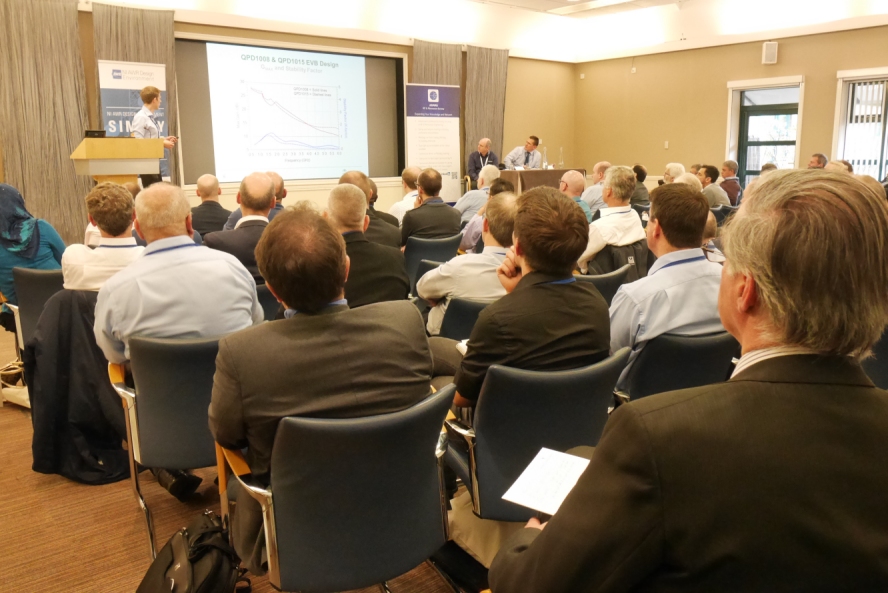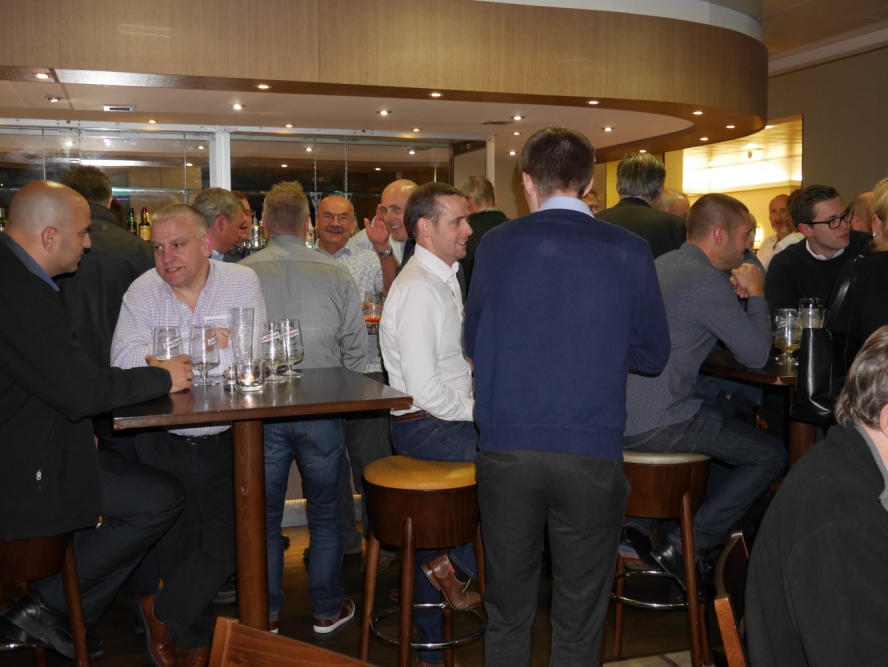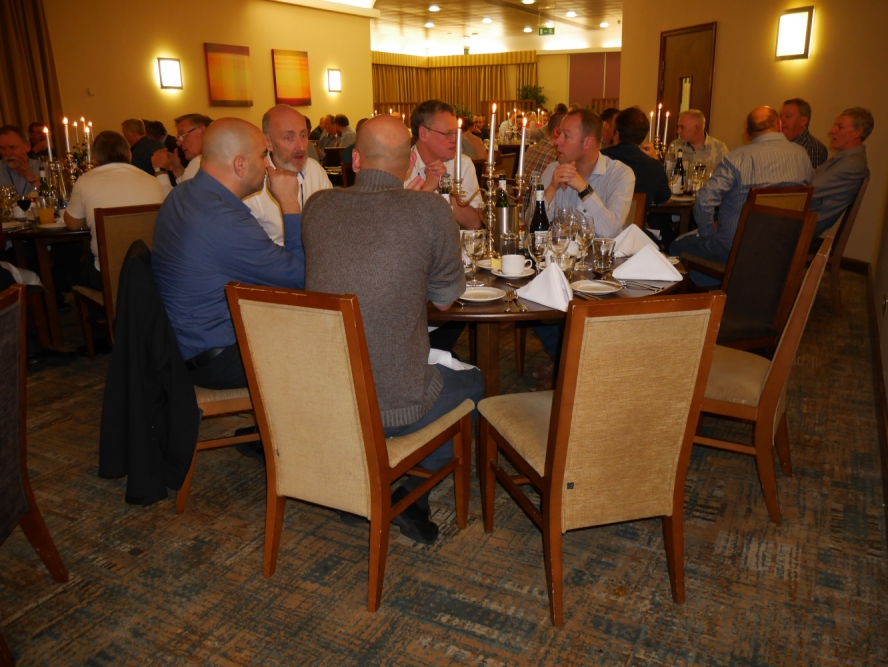Bookings for the November meeting are now closed.
The November 2016 meeting returned to Wyboston Lakes.The winner of the best paper award was David Bolton of Microsemi Corporation, the runner up was John Morrissey of Analog Devices.
Young Engineer Sponsorship: The ARMMS RF & Microwave Society provided sponsorship to two young engineers (28 or below) who had papers accepted for presentation at this meeting: Robert Smith of Plextek RFI and Yomna ElSaboni of Queens University, Belfast. Sponsorship is £100 cash plus free attendance (including conference dinner and overnight accommodation). Potential candidates should identify themselves as eligible at time of submission and state their date of birth. This offer is limited to a maximum of 2 places per meeting.
Best Paper Award: The Steve Evans-Pughe prize is awarded to the best presenter at each meeting. The award is £200 for the best paper and £50 for the runner-up. The prize is sponsored by NI.
For exhibition enquiries please email exhibition@armms.org, for all other enquiries please email enquiries@armms.org
 |  |  |
Wyboston Lakes
Great North Road
Wyboston
Bedfordshire
MK44 3AL
| Tel | 0333 7007 667 |
| sales@wybostonlakes.co.uk | |
| Web | http://www.wybostonlakes.co.uk/ |
Chris Watts
Golledge
24GHz Radar Technology Enabling Next Generation Sensors | |
| John Morrissey | |
| Analog Devices | |
A presentation showing how Multi-Channel 24GHz Radar Technology is finding a home in applications beyond Automotive. This technology also enables Smarter Sensing in both traditional & emerging Commercial & Industrial applications. The presentation provides an overview of radar technology and shows how a full signal chain radar solution can be used in several applications. | |
| 24GHz Radar Technology Enabling Next Generation Sensors | |
A Novel Low Size, Weight and Power, Multiband GNSS Antenna | |
| Dr Steven Christie | |
| Arralis | |
A novel, low size, weight and power antenna is presented for wearable and surface mounted multi-band GNSS applications. The device consists of a circularly polarised Archimedean spiral antenna placed above a novel high impedance surface. The spiral arms are meandered to reduce the surface area of the antenna, and the device thickness is reduced by using the high impedance surface, as opposed to a ground plane reflector, to provide electrical isolation on the back side of the antenna, for back-lobe suppression and prevention of grounding effects. The novel high impedance surface provides operation over GPS L1, L2 and L5, Gallileo E1, E5a and E5b, and Glonass G1 and G3 frequency bands, with return loss < 10 dB and axial ratio < 4 dB. The device measures 100 mm x 91 mm x 7.5 mm: this performance and size could not be achieved using any existing high impedance surface design. The antenna is fed with an SMA connector, with a Marchand balun used to provide a wideband impedance match from a characteristic impedance of 50 Ω in the unbalanced feed line to 130 Ω balanced antenna input impedance. | |
| A Novel Low Size, Weight and Power, Multiband GNSS Antenna | |
An Overview of WLAN: System Requirements and Practical Devices for Mobile WiFi | |
| Apostolos Samelis and Darcy Poulin | |
| Skyworks Solutions Inc | |
The new 802.11ac standard and the emerging 802.11ax WLAN standard are requiring the development of extremely linear power amplifiers. These standards also require the PA to operate with crest factors of 10dB, with RF bursts up to 5ms long, while delivering average powers of up to 500mW. This poses challenging requirements on the performance of the wireless devices. In addition to the extreme linearity requirements, the power amplifier at the end of the transmit path suffers from slow electro-thermal transients as it is responding to the WLAN bursts. This paper reviews the requirements of WLAN devices at both the system and physical level. Packaging and semiconductor technologies used in state of the art WLAN power amplifiers will be discussed, and various IC implementations will be presented. | |
| An Overview of WLAN: System Requirements and Practical Devices for Mobile WiFi | |
An X-band GaN PA MMIC for Phased Array Radar Applications | |
| Liam Devlin and Stuart Glynn | |
| Plextek RFI | |
Active phased array radars require numerous Power Amplifiers (PAs), which must be small, efficient and low-cost. This paper describes an X-band GaN PA MMIC that covers 9 to 11.5GHz and satisfies these requirements. It has an output power of 7W (38.5dBm) from a 29dBm drive with a Power Added Efficiency (PAE) of 42%. The design was realized on the 0.25µm gate length GaN on SiC process of UMS (GH25) using Keysight’s ADS 2015. The die size is just 1.5mm x 2mm, which means that around 2,300 PAs can be fabricated on a single 4” diameter wafer. | |
| An X-band GaN PA MMIC for Phased Array Radar Applications | |
Assessing the RF Performance of Medical Implant Antennas | |
| Yomna ElSaboni, Matthew K. Magill, Gareth A. Conway, William G. Scanlon | |
| Queen's University, Belfast | |
Active implantable medical devices are becoming increasingly more popular as new applications are developed to improve patient treatment and care. Many implant applications are utilising RF techniques to provide communication and control for electronic devices within the human body, especially at frequencies between 400 MHz and 2.45 GHz. Physical size is an obvious and important concern in the design of implant devices and this means that there is a need for innovation in the design of miniaturised antenna solutions that have adequate performance in the challenging human body environment. While there is a role for simulation and modelling, the test and characterisation of these innovative implant antennas is another crucial factor in the development of these medical systems. There are many issues to take into consideration that can affect the results obtained when testing miniaturized implant antennas. For example, the local environment surrounding the antenna affects both impedance matching and radiation performance and so the test environment, typically a tissue equivalent phantom is extremely important. Additionally, in practice the close proximity of the body tissues affects the antenna’s radiation performance and introduces significant losses into the reactive near fields that are associated with resonant antennas. This highlights not only the importance of accurate phantom modelling and the effect of antenna coating material, but also the source feeding techniques and characterizing its sensitivity inside the phantom. This paper will specifically illustrate the challenges faced when conducting radiation efficiency measurements for implantable antennas when they are inserted inside a tissue representative human body phantom. Our objective is to highlight the disturbance caused by the necessary feed cable and demonstrate techniques to minimize it. Only standardized antennas were used and the measurements were conducted using a novel reverberation chamber approach to obtain highly accurate results at extremely low radiation efficiencies associated with these applications. In order to gain a better understanding, the experiment was repeated with different antennas and phantom set ups and the results clearly illustrate the factors that need to be considered when assessing the RF performance of medical implant antennas. | |
| Assessing the RF Performance of Medical Implant Antennas | |
Bringing Optimized GaN Performance to L-Band Design | |
| Chris Harris | |
| Wolfspeed | |
The L-band has long been neglected by the GaN community due to the perception that other technologies provided an adequate performance. More recently the success in providing superior capability at higher frequency bands has created the demand for similar devices for the L-band. Wolfspeed has recently introduced a family of high power GaN devices specifically for L-band that in recognition of the extreme power that many such applications require, includes devices with peak power more than 900W from a single ended component. The typical advantage of the GaN technology implies that peak power is not achieved at the expense of other parameters and efficiency at the 70% level and power gain around 15dB is maintained. Internally matched devices are used to guarantee low frequency stability and by increasing the impedance presented at the lead, allow a smaller board match and compact design. The significant overall improvement in performance opens for a dramatic change in system architecture due to smaller, more efficient designs requiring less cooling and occupying less space. | |
| Bringing Optimized GaN Performance to L-Band Design | |
High-Density Packing of UHF-Microwave Devices Using Embedded Die and Integrated Silicon Passive Components | |
| David Bolton, Rhys Waite, Martin McHugh, Olivier Gaborieau, Mohamed Mehdi Jatlaoui | |
| Microsemi Corporation and IPDiA | |
The drive towards smaller, more complex, more reliable and less costly electronic devices is inexorable, and is especially pronounced in the medical implantable device market. This paper will show how the use of Microsemi Corporation proprietary embedded die technology in conjunction with an IPDiA silicon Integrated Passive Device, has made possible a reduced size, highly reproducible 400 MHz-2.4 GHz transceiver. This transceiver is unique in that the active device is embedded within a PCB, whilst the required RF matching and decoupling circuits having been integrated in silicon, are surface mounted directly above the embedded die. The only components not integrated or embedded are a SAW filter and Quartz crystal, contained within the package footprint. | |
| High-Density Packing of UHF-Microwave Devices Using Embedded Die and Integrated Silicon Passive Components | |
It's a Complex World, | |
| Philip Wilson | |
| Slipsteam Design | |
In this paper, we will look at how digital radar streams of pulse descriptor words are sorted by de-interleaving techniques to identify unique emitters. The paper will cover: 1. What is a radar pulse and how it's characterised 2. Real world data captures 3. How radar pulses are de-interleaved | |
| It's a Complex World, | |
Measuring Electro-luminescence and Photosensitivity of Trap Sites in GaN Devices | |
| M.A.Casbon, T. Brazzini, P. J. Tasker, M. Uren, M. Kuball | |
| University of Cardiff | |
Here we present a system allowing simultaneous measurement of the RF and optical behaviour of on-wafer devices, which permits Fully Active Harmonic Load-Pull techniques to be employed while either observing optical phenomena such as Electroluminescence, or applying optical stimuli for trapping investigations. Full access to the backside of the wafer is achieved, allowing measurements on devices with source coupled field plates or air bridges, which normally obscure the gate region. Electroluminescence can be observed with an ultra-low light camera or a spectrometer. Previously it has been shown that traps in GaN devices can react to light at 385nm, here the wavelength sensitivity is investigated. The test device was a GaN on silicon carbide HFET. | |
| Measuring Electro-luminescence and Photosensitivity of Trap Sites in GaN Devices | |
On the Design of Branch Amplifiers in Outphasing Systems | |
| Paolo Enrico de Falco, Kevin Morris, Souheil Ben Smida and Gavin Watkins | |
| University of Bristol | |
The outphasing method is an efficiency enhancement technique used to improve the back-off efficiency of RF amplifiers transmitting variable envelope signals. This is achieved by translating the original amplitude modulation into the phase modulation of two constant envelope signals and reconstructing the original modulation at the output. Conventional design of outphasing amplifiers consists in optimising the output combining network, while identical saturated power amplifiers are employed for each branch. In this work different power amplifier modes of operation are being evaluated as upper and lower branch PAs for outphasing systems. Rather than designing a combiner to compensate for the reactive loading, by considering the intrinsic load modulation which each PA branch sees over the outphasing range, the phase shift introduced by the matching network of each PA branch can be tuned to obtain a significant performance improvement. Simulations and measurement confirm this, proving that PAs with a fundamental reactive loading and reactive second harmonic are more suitable for outphasing operation. | |
| On the Design of Branch Amplifiers in Outphasing Systems | |
State of the Art Gyrotron Simulations and Features Needed to Make Them | |
| Jonathan Smith | |
| Tech-X UK | |
Computation has long played a role in the design of vacuum electronic devices due to the need to handle arbitrary geometry and the complicated particle/surface interactions that are often critical to their performance. Here, we present a powerful multidimensional code applicable to a wide range of vacuum electronic applications. We explore critical algorithmic advances from the last 10 years that enable state of the art simulation studies, and place these in the context of magnetrons, klystrons, gyrotrons and travelling wave tubes and passive cavities. We show the new techniques to understand the dynamics of particles in the presence of high power RF fields, their interactions with walls and the ability to handle electrically very large problems. We show how "hot test" simulation results of the high order modes found in fusion gyrotrons increase understanding of operational showstoppers. | |
| State of the Art Gyrotron Simulations and Features Needed to Make Them | |
The Design of High Performance L-band GaN PAs Using Commercially Available Discrete Transistors | |
| Robert Smith | |
| Plextek RFI | |
This paper describes the design and evaluation of a four different single stage L-Band GaN Power Amplifiers (PAs) using commercially available, low-cost packaged transistors. Two of the transistors are housed in SMT plastic packages and two in metal-based ceramic packages. The transistors are commercially available parts from Qorvo realised on a high voltage 0.25 µm GaN process. All four amplifiers have been optimised for the 0.96 to 1.215 GHz band and are designed to operate in CW or pulsed mode. The plastic packaged parts offer output powers of 11 W and 14 W with corresponding PAEs of 65% and 55%. The ceramic packaged parts offer higher output power levels of 59 W and 125 W with PAEs of 60% and 70% respectively. This paper describes the design, realisation and measurement of the four PAs, which demonstrate high performance using cost-effective commercially available transistors. | |
| The Design of High Performance L-band GaN PAs Using Commercially Available Discrete Transistors | |
The Inverted E: A Doubly-shorted F Antenna for Near-field Sensing Applications | |
| Gregory Melia, Oliver Collis, John McGreevy, Roderick Vann | |
| University of York and Sylatech Ltd | |
We describe the Inverted E antenna: a novel design of doubly-shorted patch that offers increased bandwidth and reduced axial ratio performance over a standard Inverted F design, and is smaller than a standard patch. These performance enhancements make the design ideal for use in near-field sensing arrays, and are achieved by adding a second, slightly-offset short on the opposite side from the first. The second short forces the radiating edge to remain constant with changing frequency, rather than moving as with an inverted F. The entire edge space between the two shorts then radiates, which allows a reduction in the size of the patch. This also has the effect of suppressing resonant behaviour, which increases the operating bandwidth of the antenna. The Inverted E is consistently sensitive across all polarisations, with an axial ratio < 2 dB in the near field, making it useful as a measurement antenna for sources of unknown polarisation. Prototype antennas were manufactured at Sylatech Ltd. In this paper we present simulation and experimental data for these prototypes, which show them to have a centre frequency of 9.2 GHz, a bandwidth of 300 MHz and a close approximation to circular polarization. The prototypes are now being integrated into compact high element count arrays, for which all the Inverted E's novel features are well-suited. | |
| The Inverted E: A Doubly-shorted F Antenna for Near-field Sensing Applications | |
The RF Modelling of a Ku-band Multi-port Amplifier | |
| Peter James | |
| Airbus Defence and Space (UK) Ltd | |
The object of this paper is to describe the RF modelling of a Ku-band MPA. This has been performed to compare against the measured results of an MPA demonstrator that has been designed, constructed and tested at Airbus. It will describe the modelling process and show some predicted and measured results. The model may then be used for predictions in the future prior to the construction and measurement of a real flight MPA. In addition it becomes a generic model from which future models may be based upon. | |
| The RF Modelling of a Ku-band Multi-port Amplifier | |
Companies booking two or more delegate places are able to take part in the commercial exhibition that accompanies the conference. Please note: there is a maximum of 20 exhibition tables at each meeting, these are offered on a first come basis. Booking two delegate places does not guarantee an exhibition space, please email exhibition@armms.org to check availability and reserve and exhibition space.
The Society would like to thank National Instruments for sponsoring the November 2016 meeting:
Contributions are invited with an emphasis on RF and microwave design, research, testing and associated subjects. An oral presentation will be made at the meeting and a written paper will be required for publication in the society digest, which is distributed to delegates at the meeting. Prospective speakers are requested to submit a title and a short abstract to the technical coordinator (see above) as soon as possible.
Click here to view our Guidelines for Authors
Click here to view our Publication Release Form